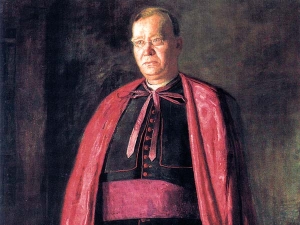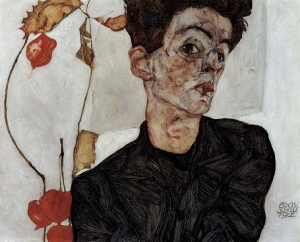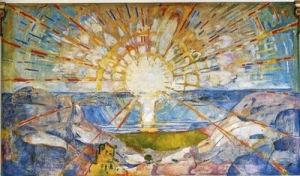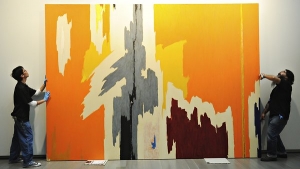|
Displaying items by tag: Expressionist
Only a short time remains for a special exhibition of the work of American modernist Gershon Benjamin (1899-1985), a Romanian-born, Montreal-educated artist remembered as an Expressionist for his individualistic style and use of color. The exhibition, Gershon Benjamin: Modern Master features more than 60 portraits, still lifes, landscapes and city scenes in oil, watercolor and charcoal—all representing more than seven decades of work.
Benjamin was part of a 1920s New York scene of progressive artists who favored European modernism to the popular American Scene and Regionalist art of the day.
Paris’ Fondation Louis Vuitton collection was designed according to four axes: contemplative, subjective expressionist, Pop art, and music/sound. Following two hangings—the first in the autumn of 2014, which exhibited a limited set of works representative of the four categories and from the field of architecture, and the second taking place in the winter of 2014 until the spring of 2015, adhering to the expressionist and contemplative axes—the third part of the collection was inaugurated on June 3, 2015, bringing together Pop art and sound works, which are to be exhibited until October 2015.
How did El Greco move from painting icons on the island of Crete to the elongated, expressionist works that made him famous and influenced artists like Pablo Picasso and Paul Cézanne? To mark the 400th anniversary of the artist’s death, three New York City museums are trying to provide an answer.
On Tuesday, the Metropolitan Museum of Art will bring out its nine El Greco paintings as well as another six lent from the Hispanic Society.
The similarities between two art works being auctioned next month by Christie’s and Sotheby’s in New York are striking. Both were created by the Austrian Expressionist Egon Schiele. And both once belonged to Fritz Grünbaum, a Viennese cabaret performer whose large art collection was inventoried by Nazi agents after he was sent to the Dachau concentration camp, where he died.
But there is also a notable difference in the way the houses are handling the sales.
Though he died at age 27 in 1988, artist Jean-Michel Basquiat remains among the brightest of American art stars. For a short time, he was a street artist in New York's burgeoning 1970s graffiti scene. His tag, SAMO, became a graffiti icon.
Not long after, Basquiat climbed to the highest rungs of the rarified Manhattan art world, eventually even collaborating on paintings with pop legend Andy Warhol. His celebrity was almost unparalleled among visual artists. His expressionist paintings now hang in museums across the globe and sell for tens of millions. Reebok recently released a line of athletic shoes decorated with Basquiat images.

The St. Charles Borromeo Seminary in Wynnewood, Pennsylvania, will sell a number of works from its extensive fine art collection, including five portraits by Thomas Eakins. Eakins, a realist who lived and worked in Philadelphia, is widely considered one of the most important American artists in history.
Christie’s will facilitate a private consignment sale of the works, which mostly feature past faculty members and have been in the seminary’s possession for around 80 years. A sixth Eakins painting, which was loaned to the seminary by the American Catholic Historical Society, will also be put up for consignment. In addition, the seminary is consigning a painting by the American Impressionist Colin Campbell Cooper as well as a work by the expressionist painter Alice Neel. Bonhams and Sotheby’s will broker those sales respectively.
Before deciding to sell the works, the seminary had a committee of arts specialists and seminary alumni and administrators conduct a year-long study. The seminary looked into partnering with local museums and historical societies, hoping that one would offer to acquire the paintings, but none of the organizations voiced interest.
Proceeds from the sales will help fund a major renovation of St. Charles’ Main Line campus, which will include making the seminary smaller and renovating its existing facilities.

An unpublished sketchbook belonging to the Austrian painter Egon Schiele (1890-1918) has surfaced from a private collection. Dating back to 1906 when Schiele enrolled at the Vienna Academy of Fine Arts where he was to meet his future mentor, Gustave Klimt (1862-1918), the sketchbook contains over 40 never-before-seen works by the artist. The images will be reproduced later this month in Egon Schiele: The Beginning, the first book to explore the expressionist’s early works.
Schiele was an important figurative painter of the 20th century and many of his works are erotically charged and noted for their raw emotional intensity. Schiele’s early sketchbook includes a self-portrait and various landscapes that illustrate his early predilection for the expressive brush strokes and dramatic lines that are now readily associated with his work.
Egon Schiele: The Beginning will also include sketches Schiele completed in 1905 on an old English dictionary. Only one of the dictionary sketches has been exhibited before.

A monumental frieze made between 1909 and 1916 by Edvard Munch (1863-1944) adorns the walls of the University of Oslo’s assembly hall in Norway. The frieze, which includes 11 different Expressionist paintings, underwent a lengthy restoration and conservation process a last year. However, just 20 months after the project was completed, the frieze might be at risk.
Tine Frøysaker, a Norwegian conservator and professor at the University of Oslo, announced that while the exterior of the building that houses the frieze is being restored, harmful dust and debris could be damaging Munch’s masterpiece. Frøysaker, who worked on the frieze, explained that the plaster that is being knocked off the building’s exterior is releasing particles that contain alkaline, which is highly abrasive. If these particles come in contact with the frieze, which is likely since the building is old and impossible to seal off, the paintings could be damaged. Steps have been taken to lessen any impairment by increasing the building’s internal air pressure, which will hopefully keep most particles out of the building.
Frøysaker said that this potentially harmful situation could have been avoided if the exterior restoration was completed before tackling the Munch frieze inside. Work on the building’s exterior is expected to finish during the summer of 2013. Upon completion, conservators will need to assess the paintings to determine if additional restoration is needed.

It was a crisp fall day here, and the new Clyfford Still Museum was humming with activity. Works by Still, the institution’s Abstract Expressionist namesake, had begun arriving in the galleries a couple of days back, and now the 60 paintings that were going on view had been unpacked and propped on blocks, leaning against the walls. Many had never been seen by more than a handful of people.
For some — like Dean Sobel, director of the museum — it was a moment of discovery. Although he had spent years inspecting the paintings in storage in Maryland, where they had been sequestered since the ferociously unsociable Still moved there in 1961, Mr. Sobel had never had the opportunity to look at this large a grouping en masse, or even on stretchers.
“We stretched this yesterday,” Mr. Sobel said, pointing to a 16-foot-long canvas Still had painted in 1951, around the time he began cutting his ties to galleries, then museums, then the rest of the art world. Glowing with thickly impastoed blue oil paint, it was roughly bisected by a vertical black band and a flamelike crimson streak, one of Still’s “life lines,” as he termed them. He had been persuaded to exhibit it only once, at the 1963 opening of the Institute of Contemporary Art in Philadelphia. Nearby two more rolled-up paintings from the 1970s lay waiting for their own stretcher-bar debut. Other canvases around them blazed with color, looking as fresh as if they had just come from Still’s studio.
“It’s a pristine collection,” Mr. Sobel said happily.
Someone else in the museum that day had more bittersweet emotions, however: Still’s younger daughter, Sandra Still Campbell. She was clearly delighted to rediscover the paintings, many of which she had lived with growing up. “If you get close enough, you can still smell the paint and the linseed oil,” she said, gazing teary eyed at an ochre painting from 1949. “These are old friends. It’s, like, ‘Hey, siblings, you’re back!’ ”
Yet as co-executor (together with her older sister, Diane Still Knox) of her father’s estate, Ms. Campbell was nervous about opening his work up to public scrutiny. “Dad didn’t need anybody to tell him what he was about,” she said. “He didn’t like being analyzed. And now he’s going to be analyzed to death.”
A founder of Abstract Expressionism, along with Rothko and Pollock (who said, “Still makes the rest of us look academic”), Still these days is most notable for being the least known of that pioneering group. In life he sold or gave away only about 150 paintings, and he tightly controlled how and when his work was shown. After his death in 1980 at 75 his widow and initial executor, Patricia Still, guarded his work just as jealously, selling or giving away only 12 paintings and largely refusing to let the rest be seen by anyone, including scholars.
|
|
|
|
|